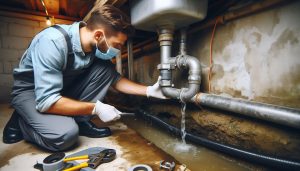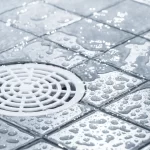Leaky pipes are a common issue that can lead to significant damage if not addressed promptly. As a homeowner, it’s crucial to identify and fix leaks early to prevent costly repairs and maintain the integrity of your home. In this guide, we will explore how to identify leaky pipes, the steps to fix them, and preventative measures to avoid future leaks.
Signs of Leaky Pipes
Identifying a leaky pipe early can save you from extensive damage and high repair costs. Here are some common signs to look out for:
- Water Stains: Look for water stains on ceilings, walls, and floors. These stains are often yellowish-brown and indicate a leak in the plumbing above or behind the stained area.
- Mold and Mildew: Persistent mold and mildew growth, especially in areas not typically exposed to moisture, can be a sign of a hidden leak.
- Musty Odors: A musty smell in your home can indicate water damage caused by a leaky pipe.
- Increased Water Bills: A sudden spike in your water bill without a corresponding increase in usage can signal a leak.
- Wet Spots: Unexplained wet spots on floors, walls, or ceilings are a clear indication of a leak.
- Sound of Running Water: If you hear the sound of running water when all fixtures are turned off, it could mean there’s a leak somewhere in your plumbing system.
Common Causes of Leaky Pipes
Understanding the common causes of leaky pipes can help you prevent them. Here are some typical reasons pipes may start to leak:
- Corrosion: Over time, pipes can corrode, leading to leaks. This is especially common in older homes with galvanized steel or copper pipes.
- High Water Pressure: Excessive water pressure can strain pipes and cause them to burst or develop leaks.
- Temperature Changes: Extreme temperature fluctuations can cause pipes to expand and contract, leading to cracks and leaks.
- Tree Roots: Tree roots can invade underground pipes, causing them to crack and leak.
- Clogs: Blockages in pipes can increase pressure and lead to leaks at weak points.
- Poor Installation: Improperly installed pipes and fittings can lead to leaks over time.
How to Identify Leaky Pipes
Identifying the source of a leak can be challenging, but these steps can help you locate it:
- Check Visible Pipes: Inspect all visible pipes for signs of moisture, corrosion, or damage.
- Monitor Your Water Meter: Turn off all water fixtures and check your water meter. If the meter continues to run, you likely have a leak.
- Use Food Coloring: Add a few drops of food coloring to your toilet tank. If the color appears in the bowl without flushing, you have a leak in the toilet.
- Inspect Appliances: Check around appliances like dishwashers, washing machines, and water heaters for signs of leaks.
- Hire a Professional: If you can’t locate the leak, consider hiring a professional plumber who can use specialized equipment to find hidden leaks.
Steps to Fix Leaky Pipes
Once you’ve identified a leaky pipe, it’s essential to fix it promptly to prevent further damage. Here’s a step-by-step guide to fixing common types of leaks:
1. Fixing a Leaky Joint
Leaky joints are common and can often be fixed with pipe joint compound or plumber’s tape:
- Turn Off the Water Supply: Shut off the water supply to the affected area.
- Disassemble the Joint: Use a wrench to carefully disassemble the leaking joint.
- Apply Pipe Joint Compound: Clean the threads and apply pipe joint compound or plumber’s tape to the threads.
- Reassemble the Joint: Reassemble the joint and tighten it securely.
- Turn On the Water Supply: Turn the water supply back on and check for leaks.
2. Fixing a Leaky Pipe with Epoxy Putty
Epoxy putty is a quick and effective way to fix small leaks in pipes:
- Turn Off the Water Supply: Shut off the water supply to the affected area.
- Clean the Area: Clean the area around the leak with a cloth and sandpaper.
- Prepare the Epoxy Putty: Cut a piece of epoxy putty and knead it until it’s a uniform color.
- Apply the Putty: Press the putty over the leak and smooth it out.
- Let It Cure: Allow the putty to cure according to the manufacturer’s instructions.
- Turn On the Water Supply: Turn the water supply back on and check for leaks.
3. Fixing a Leaky Pipe with a Pipe Clamp
A pipe clamp is a temporary fix for larger leaks:
- Turn Off the Water Supply: Shut off the water supply to the affected area.
- Clean the Area: Clean the area around the leak with a cloth.
- Apply the Pipe Clamp: Place the rubber gasket over the leak and secure the clamp around the pipe.
- Tighten the Clamp: Tighten the clamp screws to create a seal.
- Turn On the Water Supply: Turn the water supply back on and check for leaks.
Preventative Measures to Avoid Future Leaks
Preventing leaks is always better than fixing them. Here are some preventative measures to keep your plumbing system in good condition:
- Regular Inspections: Schedule regular inspections of your plumbing system to catch potential issues early.
- Reduce Water Pressure: Install a pressure regulator to keep your water pressure at a safe level.
- Insulate Pipes: Insulate pipes in unheated areas to prevent them from freezing and bursting during cold weather.
- Maintain Your Water Heater: Regularly maintain your water heater to prevent leaks and extend its lifespan.
- Avoid Chemical Drain Cleaners: Chemical drain cleaners can corrode pipes over time. Use natural alternatives or call a professional for stubborn clogs.
- Monitor Tree Roots: Keep an eye on trees near your plumbing system and consider root barriers to prevent root intrusion.
When to Call a Professional
While many minor leaks can be fixed with DIY methods, there are times when it’s best to call a professional plumber:
- Persistent Leaks: If you’ve tried to fix a leak multiple times without success, it’s time to call a professional.
- Major Leaks: Large leaks or burst pipes require immediate professional attention.
- Hidden Leaks: If you suspect a hidden leak but can’t locate it, a professional plumber can use specialized equipment to find and fix it.
- Water Damage: If you notice significant water damage, mold, or mildew, it’s essential to call a professional to address the issue and prevent further damage.
Conclusion
Identifying and fixing leaky pipes before they cause major damage is crucial for maintaining the integrity of your home. By understanding the signs of leaks, common causes, and effective repair methods, you can protect your home from water damage and costly repairs. Regular maintenance and preventative measures can also help you avoid future leaks and keep your plumbing system in top condition.
If you’re dealing with a leaky pipe or need professional plumbing assistance, don’t hesitate to contact Absolute Draining & Plumbing. Our experienced team is here to help you with all your plumbing needs, from leak detection to emergency repairs. Contact us today to schedule a consultation and ensure your home’s plumbing system is in excellent condition.
Additional Resources
For more information on identifying and fixing leaky pipes, check out these helpful resources:







